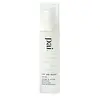What's inside
What's inside
 Key Ingredients
Key Ingredients

 Benefits
Benefits

 Concerns
Concerns

 Ingredients Side-by-side
Ingredients Side-by-side

Water
Skin ConditioningSimmondsia Chinensis Seed Oil
EmollientPersea Gratissima Oil
Skin ConditioningCarthamus Tinctorius Seed Oil
MaskingCetearyl Alcohol
EmollientGlycerin
HumectantBorago Officinalis Seed Oil
EmollientButyrospermum Parkii Butter
Skin ConditioningCetearyl Glucoside
EmulsifyingPelargonium Graveolens Oil
MaskingLitsea Cubeba Fruit Oil
MaskingJasminum Grandiflorum Flower Extract
MaskingTocopherol
AntioxidantHelianthus Annuus Seed Oil
EmollientSodium Levulinate
Skin ConditioningSodium Anisate
AntimicrobialSodium Stearoyl Glutamate
CleansingSodium Caproyl/Lauroyl Lactylate
AntimicrobialLactic Acid
BufferingBeta-Sitosterol
Emulsion StabilisingSqualene
EmollientWater, Simmondsia Chinensis Seed Oil, Persea Gratissima Oil, Carthamus Tinctorius Seed Oil, Cetearyl Alcohol, Glycerin, Borago Officinalis Seed Oil, Butyrospermum Parkii Butter, Cetearyl Glucoside, Pelargonium Graveolens Oil, Litsea Cubeba Fruit Oil, Jasminum Grandiflorum Flower Extract, Tocopherol, Helianthus Annuus Seed Oil, Sodium Levulinate, Sodium Anisate, Sodium Stearoyl Glutamate, Sodium Caproyl/Lauroyl Lactylate, Lactic Acid, Beta-Sitosterol, Squalene
Water
Skin ConditioningCaprylic/Capric Triglyceride
MaskingPropanediol
SolventCetearyl Alcohol
EmollientGlycerin
HumectantPanthenol
Skin ConditioningPrunus Armeniaca Kernel Oil
MaskingOleic/Linoleic/Linolenic Polyglycerides
EmollientCetearyl Olivate
Xylitylglucoside
HumectantEctoin
Skin ConditioningSqualane
EmollientAnhydroxylitol
HumectantSorbitan Olivate
EmulsifyingPotassium Cetyl Phosphate
EmulsifyingPhenoxyethanol
PreservativeCarbomer
Emulsion StabilisingGlyceryl Stearate
EmollientJojoba Esters
EmollientBenzyl Alcohol
PerfumingMaltodextrin
AbsorbentXylitol
HumectantSodium Lauroyl Lactylate
EmulsifyingButylene Glycol
HumectantDisodium Stearoyl Glutamate
CleansingHelianthus Annuus Seed Wax
Skin ConditioningSodium Hydroxide
BufferingMadecassoside
AntioxidantLactobacillus Ferment
Skin ConditioningEthylhexylglycerin
Skin ConditioningDehydroacetic Acid
PreservativeCeramide NP
Skin ConditioningHelianthus Annuus Sprout Extract
Skin ConditioningCeramide AP
Skin ConditioningPhytosphingosine
Skin ConditioningCholesterol
EmollientPolyglycerin-3
HumectantXanthan Gum
EmulsifyingSodium Benzoate
MaskingCentella Asiatica Leaf Extract
Skin ConditioningCeramide EOP
Skin ConditioningWater, Caprylic/Capric Triglyceride, Propanediol, Cetearyl Alcohol, Glycerin, Panthenol, Prunus Armeniaca Kernel Oil, Oleic/Linoleic/Linolenic Polyglycerides, Cetearyl Olivate, Xylitylglucoside, Ectoin, Squalane, Anhydroxylitol, Sorbitan Olivate, Potassium Cetyl Phosphate, Phenoxyethanol, Carbomer, Glyceryl Stearate, Jojoba Esters, Benzyl Alcohol, Maltodextrin, Xylitol, Sodium Lauroyl Lactylate, Butylene Glycol, Disodium Stearoyl Glutamate, Helianthus Annuus Seed Wax, Sodium Hydroxide, Madecassoside, Lactobacillus Ferment, Ethylhexylglycerin, Dehydroacetic Acid, Ceramide NP, Helianthus Annuus Sprout Extract, Ceramide AP, Phytosphingosine, Cholesterol, Polyglycerin-3, Xanthan Gum, Sodium Benzoate, Centella Asiatica Leaf Extract, Ceramide EOP
 Reviews
Reviews

Ingredients Explained
These ingredients are found in both products.
Ingredients higher up in an ingredient list are typically present in a larger amount.
Cetearyl alcohol is a mixture of two fatty alcohols: cetyl alcohol and stearyl alcohol. It is mainly used as an emulsifier. Emulsifiers help prevent the separation of oils and products. Due to its composition, it can also be used to thicken a product or help create foam.
Cetearyl alcohol is an emollient. Emollients help soothe and hydrate the skin by trapping moisture.
Studies show Cetearyl alcohol is non-toxic and non-irritating. The FDA allows products labeled "alcohol-free" to have fatty alcohols.
This ingredient is usually derived from plant oils such as palm, vegetable, or coconut oils. There is debate on whether this ingredient will cause acne.
Due to the fatty acid base, this ingredient may not be Malassezia folliculitis safe.
Learn more about Cetearyl AlcoholGlycerin is already naturally found in your skin. It helps moisturize and protect your skin.
A study from 2016 found glycerin to be more effective as a humectant than AHAs and hyaluronic acid.
As a humectant, it helps the skin stay hydrated by pulling moisture to your skin. The low molecular weight of glycerin allows it to pull moisture into the deeper layers of your skin.
Hydrated skin improves your skin barrier; Your skin barrier helps protect against irritants and bacteria.
Glycerin has also been found to have antimicrobial and antiviral properties. Due to these properties, glycerin is often used in wound and burn treatments.
In cosmetics, glycerin is usually derived from plants such as soybean or palm. However, it can also be sourced from animals, such as tallow or animal fat.
This ingredient is organic, colorless, odorless, and non-toxic.
Glycerin is the name for this ingredient in American English. British English uses Glycerol/Glycerine.
Learn more about GlycerinWater. It's the most common cosmetic ingredient of all. You'll usually see it at the top of ingredient lists, meaning that it makes up the largest part of the product.
So why is it so popular? Water most often acts as a solvent - this means that it helps dissolve other ingredients into the formulation.
You'll also recognize water as that liquid we all need to stay alive. If you see this, drink a glass of water. Stay hydrated!
Learn more about Water